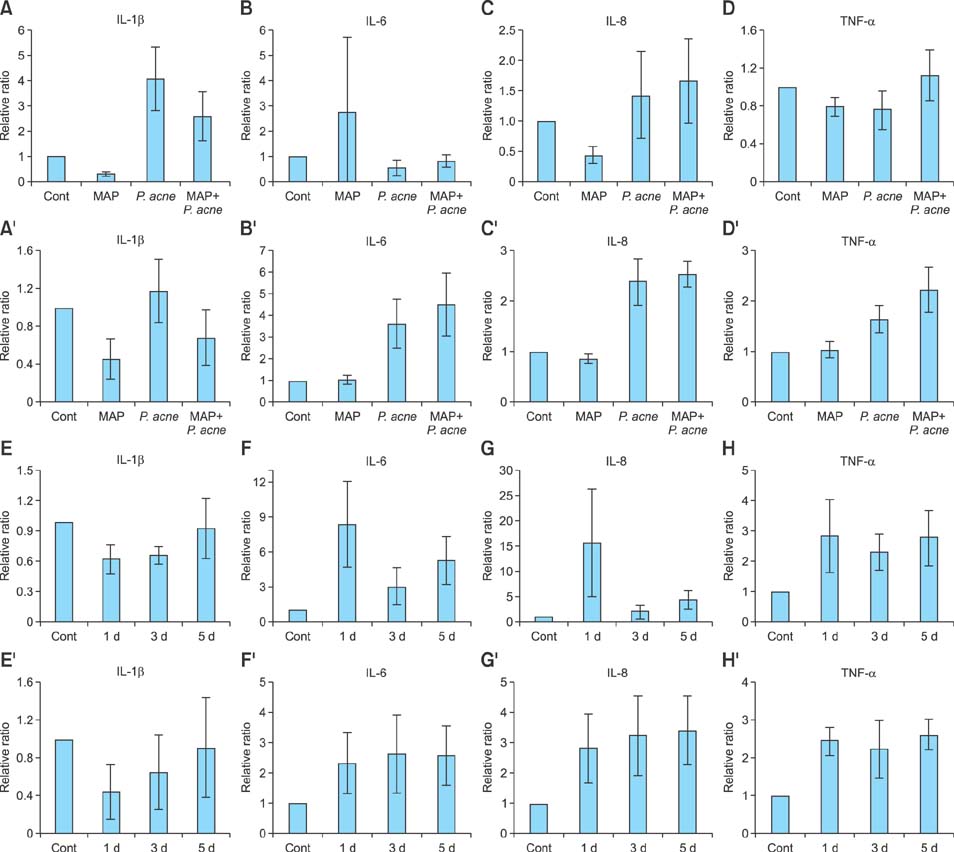Ann Dermatol.
2016 Feb;28(1):129-132. 10.5021/ad.2016.28.1.129.
Effects of Magnesium Ascorbyl Phosphate on the Expression of Inflammatory Biomarkers after Treatment of Cultured Sebocytes with Propionibacterium acnes or Ultraviolet B Radiation
- Affiliations
-
- 1Department of Dermatology, Kyungpook National University School of Medicine, Daegu, Korea. weonju@knu.ac.kr
- KMID: 2429501
- DOI: http://doi.org/10.5021/ad.2016.28.1.129
Abstract
- No abstract available.
Figure
Reference
-
1. Winston MH, Shalita AR. Acne vulgaris. Pathogenesis and treatment. Pediatr Clin North Am. 1991; 38:889–903.
Article2. Zouboulis CC. Acne and sebaceous gland function. Clin Dermatol. 2004; 22:360–366.
Article3. Zouboulis CC, Adjaye J, Akamatsu H, Moe-Behrens G, Niemann C. Human skin stem cells and the ageing process. Exp Gerontol. 2008; 43:986–997.
Article4. Park YK, Chung WS, Lee H, Jung SW. Whitening effect of cosmetics containing magnesium l-ascorbyl-2-phosphate (VC-PMG, vitamin C derivatives) assessed by colorimeter. Ann Dermatol. 2002; 14:63–70.
Article5. Nagy I, Pivarcsi A, Kis K, Koreck A, Bodai L, McDowell A, et al. Propionibacterium acnes and lipopolysaccharide induce the expression of antimicrobial peptides and proinflammatory cytokines/chemokines in human sebocytes. Microbes Infect. 2006; 8:2195–2205.
Article6. Skiba B, Neill B, Piva TJ. Gene expression profiles of TNF-alpha, TACE, furin, IL-1beta and matrilysin in UVA- and UVB-irradiated HaCat cells. Photodermatol Photoimmunol Photomed. 2005; 21:173–182.
Article7. Lee WJ, Park KH, Sohn MY, Lee WC, Lee SJ, Kim do W. Ultraviolet B irradiation increases the expression of inflammatory cytokines in cultured sebocytes. J Dermatol. 2013; 40:993–997.
Article8. Lesnik RH, Kligman LH, Kligman AM. Agents that cause enlargement of sebaceous glands in hairless mice. II. Ultraviolet radiation. Arch Dermatol Res. 1992; 284:106–108.
Article9. Akitomo Y, Akamatsu H, Okano Y, Masaki H, Horio T. Effects of UV irradiation on the sebaceous gland and sebum secretion in hamsters. J Dermatol Sci. 2003; 31:151–159.10. Ayres S Jr, Mihan R. Acne vulgaris: therapy directed at pathophysiologic defects. Cutis. 1981; 28:41–42.
- Full Text Links
- Actions
-
Cited
- CITED
-
- Close
- Share
- Similar articles
-
- Effect of Vitamin D on the Expression of Inflammatory Biomarkers in Cultured Sebocytes Treated with Propionibacterium acnes or Ultraviolet B Irradiation
- Magnesium Ascorbyl Phosphate Regulates the Expression of Inflammatory Biomarkers in Cultured Sebocytes
- Inflammatory Cytokine Expression and Sebum Production after Exposure of Cultured Human Sebocytes to Ultraviolet A Radiation and Light at Wavelengths of 650 nm and 830 nm
- Dieckol Inhibits the Effects of Particulate Matter 10 on Sebocytes, Outer Root Sheath Cells, and Cutibacterium Acnes−Pretreated Mice
- Red Ginseng Acidic Polysaccharides Promote the Expression of Acne-Related Inflammatory Biomarkers in Lipopolysaccharide-Treated Sebocytes and Outer Root Sheath Cells and Cutibacterium acnes-Injected Mice



